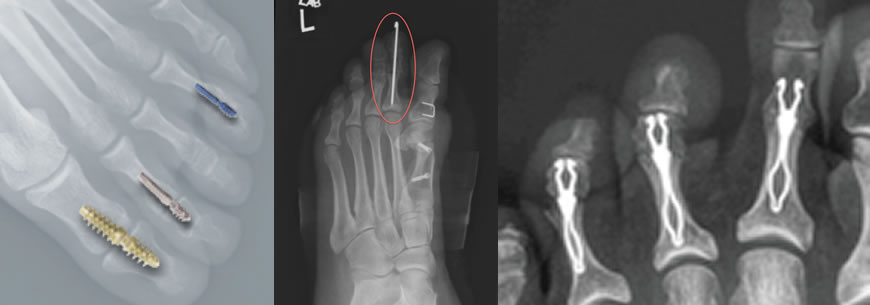in Foot and Ankle Surgery and Reconstruction
It is usually a day-case procedure. The operation can be done under local or general anaesthesia (with an added injection during the operation in the foot to numb the foot for pain relief after surgery). The operation in general will involve 1-2 incisions around each toe that requires straightening. The procedure involves straightening the toe at the joint (or joints) where it is bent. The toe is then held straight with either a thin metal wire which protrudes slightly from the end of the toe or a special screw/clip device inside the toe. Dissolvable skin stitches may be used. The toe fusion operation may, in some cases, be performed in conjunction with another procedure for example a bunion procedure.

Your foot will be bandaged, numb and should be pain free. There may be short wires visible at the end of the toe (these will be removed with a gentle pull, pain-free, in the out-patient clinic after 4 weeks). You will see a physiotherapist who will advise on walking in a padded stiff shoe that will be supplied. You will be discharged only when comfortable and given an out-patient appointment and pain-killers as required.
Your physiotherapist will guide you through the stages of rehabilitation including gait re-education, toe exercises, swelling reduction and reducing muscle tightness. It is important to adhere to advice given.
In the first 4 weeks keep the foot dry. You may shower with a waterproof cover over the foot. After 4 weeks you can only shower if the wounds are healed but gently dab the wound dry.
Do not pull at scabs but let them fall away naturally. If your wound becomes red, swollen or sore you need to see your Consultant to ensure there is no infection present. Your physiotherapist may advise on wound massage when it has healed.
DVLA states it is the responsibility of the driver to ensure they are always in control of the vehicle. A good guide is if you can stamp down hard with the foot to stop the car in an emergency stop. This will take at least 6 weeks. Click here to read DVLA guidance.
This is very individual and job-dependent. Below is a guide:
Good symptom relief with a straight toe once the wound heals and the toe has fused can take 4-6 weeks. Rapid return to activity and sports in comfortable shoes by 2-3 months is possible. Fusion operations have good outcomes generally with 90% of patients happy. Mild swelling can persist in the toe for up to a year.
Any operation carries a risk. Below is a guide to some risks potentially encountered. It is the surgeons duty to fully inform you of possible risks. Mr Roche will ensure this is always done so patients can make safe and informed choices about their operation.
If this happens, it is usually treated with antibiotics. Significant consequences from infection are very rare but can be dealt with. Risk is around 1%.
Nerves that supply sensation to the skin are near the incision site. Damage is rare but if your toe stays numb after surgery, the nerve may be bruised. If so it usually recovers. Risk is around 5%.
This means the bones fail to biologically fuse. Invariably it is “painless” and intervention is not needed. Risk is possibly up to 30%, but not often a problem to the patient. If symptomatic then treatment options will be discussed.
Symptomatic clot formation in the leg is unusual after foot surgery (<3%). Whether treatment to prevent clot is needed can be discussed with your surgeon. There is no consensus amongst UK Orthopaedic surgeons as to whether preventative medicine is needed.
This document is only meant to be a guideline to help you understand your treatment and what to expect. Every person is different and your rehabilitation may be quicker and slower. This will be advised and guided by your doctor and physiotherapist.